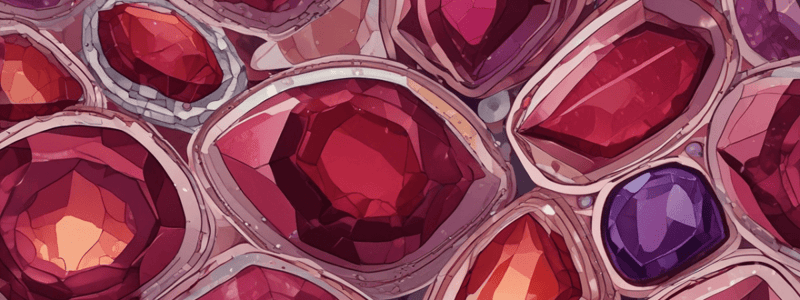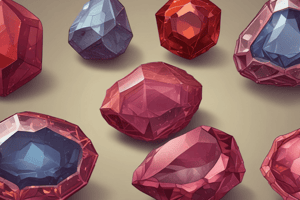Podcast
Questions and Answers
What is the name of the pure yellow andradite?
What is the name of the pure yellow andradite?
- Hessonite
- Spessartine
- Topazolite (correct)
- Malaya
What is the color range of Pyrope garnet?
What is the color range of Pyrope garnet?
- Pinkish orange to peach color
- Dark, purplish raspberry red to light reddish purple
- Pale yellowish orange to dark brownish red
- Orange-red to strongly reddish purple (correct)
Which type of garnet has a brownish hue and a range of orange to cinnamon colors?
Which type of garnet has a brownish hue and a range of orange to cinnamon colors?
- Spessartine
- Rhodolite
- Malaya
- Hessonite (correct)
What is the characteristic of the best Rhodolite gems?
What is the characteristic of the best Rhodolite gems?
What is the name of the garnet that is a mix of pyrope, spessartine, and small amount of almandine?
What is the name of the garnet that is a mix of pyrope, spessartine, and small amount of almandine?
What is the characteristic of Pyrope-Almandine Mix garnet?
What is the characteristic of Pyrope-Almandine Mix garnet?
What is the color of Spessartine garnet?
What is the color of Spessartine garnet?
What is the common habit of Demantoid crystals?
What is the common habit of Demantoid crystals?
What is the characteristic of Demantoid inclusions?
What is the characteristic of Demantoid inclusions?
What is the origin of Demantoid associated with royalty?
What is the origin of Demantoid associated with royalty?
What is the trade name for Demantoid with a greenish-yellow color?
What is the trade name for Demantoid with a greenish-yellow color?
Where are high-quality Demantoid rough stones typically sent for cutting?
Where are high-quality Demantoid rough stones typically sent for cutting?
What is the characteristic of Demantoid crystals that can increase their value?
What is the characteristic of Demantoid crystals that can increase their value?
What is the common size range for Demantoid used in pave settings?
What is the common size range for Demantoid used in pave settings?
What is the origin of Demantoid known for high-quality stones?
What is the origin of Demantoid known for high-quality stones?
Why is Demantoid rarely found in large sizes?
Why is Demantoid rarely found in large sizes?
What is the hardness of Demantoid on the Mohs scale?
What is the hardness of Demantoid on the Mohs scale?
What is the best color of Demantoid garnet?
What is the best color of Demantoid garnet?
What is unique about the dispersion value of Demantoid?
What is unique about the dispersion value of Demantoid?
What is Demantoid a variety of?
What is Demantoid a variety of?
What is the color range of Demantoid?
What is the color range of Demantoid?
What is the rarity of intense green Demantoid?
What is the rarity of intense green Demantoid?
What is the tone of the best Demantoid color?
What is the tone of the best Demantoid color?
What is the saturation level of the best Demantoid color?
What is the saturation level of the best Demantoid color?
What is the characteristic hue of highly saturated Spessartine garnet?
What is the characteristic hue of highly saturated Spessartine garnet?
Which of the following colors is NOT a characteristic of Spessartine garnet?
Which of the following colors is NOT a characteristic of Spessartine garnet?
What is the tone of highly saturated Spessartine garnet?
What is the tone of highly saturated Spessartine garnet?
Which of the following is NOT a characteristic of Spessartine garnet?
Which of the following is NOT a characteristic of Spessartine garnet?
What is the characteristic color range of Spessartine garnet?
What is the characteristic color range of Spessartine garnet?
What is the primary consumer market for Tsavorite?
What is the primary consumer market for Tsavorite?
How does the price of a high-quality red spinel compare to a similar ruby?
How does the price of a high-quality red spinel compare to a similar ruby?
What is the Mohs scale hardness of Demantoid garnet?
What is the Mohs scale hardness of Demantoid garnet?
What is the characteristic of Mogok spinel that is highly prized by collectors?
What is the characteristic of Mogok spinel that is highly prized by collectors?
How many species of garnet are commercially imported as gems?
How many species of garnet are commercially imported as gems?
What is the characteristic of the most prized Tsavorite garnets?
What is the characteristic of the most prized Tsavorite garnets?
Which of the following elements is responsible for the color of Spessartine?
Which of the following elements is responsible for the color of Spessartine?
In which type of rocks can Spessartine be found?
In which type of rocks can Spessartine be found?
What is the characteristic of Spessartine that makes it suitable for large cuts?
What is the characteristic of Spessartine that makes it suitable for large cuts?
Which of the following countries is known for producing large Spessartine stones?
Which of the following countries is known for producing large Spessartine stones?
What is the trade name for Spessartine with a dark-toned orange-red to brownish red color?
What is the trade name for Spessartine with a dark-toned orange-red to brownish red color?
Where are Spessartine rough stones typically sent for cutting?
Where are Spessartine rough stones typically sent for cutting?
What is the characteristic of Spessartine inclusions?
What is the characteristic of Spessartine inclusions?
Which of the following countries is not a known source of Spessartine?
Which of the following countries is not a known source of Spessartine?
What is the crystal structure of Spessartine?
What is the crystal structure of Spessartine?
What is the refractive index of Spessartine?
What is the refractive index of Spessartine?
Flashcards are hidden until you start studying
Study Notes
Garnet Types and Characteristics
- Topazolite: a pure yellow andradite
- Spessartine: pale yellowish orange to dark brownish red, with a highly saturated, reddish orange hue and medium to medium-dark tone
- Malaya: a pinkish orange mix of pyrope, spessartine, and almandine, often referred to as "peach" or "cinnamon"
- Hessonite: an orange to cinnamon-colored variety of grossular garnet with a brownish hue
- Rhodolite: a range of dark, purplish raspberry red to light reddish purple, with a medium to medium-dark tone and strong saturation
Garnet Chemical Composition
- Garnet: basic composition is silicon, oxygen, and aluminum, with isomorphous replacement being possible
- Tsavorite: a trace element of vanadium
- Demantoid: a trace element of chromium and iron
- Spessartine: a trace element of manganese and iron
- Hessonite: a trace element of manganese and iron
- Pyrope: top stones have a trace element of chromium and iron, with less vibrant hues
- Spinel: intense reds and pinks are caused by traces of chromium, while orange and purple stones owe their color to a mixture of iron and chromium
Forming Sources
- Garnets: formed in metamorphic rocks and pegmatite veins
- Demantoid: formed in volcanic and metamorphic rocks
- Spessartine: formed in pegmatites and metamorphic rocks
- Rhodolite: formed in alluvial deposits and metamorphic rocks
- Almandine: formed in metamorphic rocks like schist
- Spinel: formed in marble and alluvial deposits
Crystal Structure
- Garnets: all have a cubic crystal system, with the most common habit being dodecahedron
- Tsavorite: rarely forms well-formed crystals, often in irregular nodules called "potatoes" or "pods"
- Spinel: has a cubic crystal system, with a crystal habit of an octahedron, and can form flattened twin crystals
Clarity and Inclusions
- Garnet and Spinel: are singly refractive
- Tsavorite: has an extinction in darker stones
- Demantoid: has curving, radiating bundles of fibers known as "horsetails", which can increase the value of a stone
- Hessonite: most hessonite is highly included, with inclusions causing an instantly recognizable "heat wave" or "scotch-in-water" effect
Garnet Species
- There are 20 garnet species, with only 5 commercially imported as gems.
- Many garnets are mixtures of two or more garnet species.
Demantoid
- A variety of andradite garnet.
- Chemical composition is silicon, oxygen, and aluminum, with isomorphous replacement being possible.
- Trace elements of chromium and iron.
- Found in volcanic and metamorphic rocks.
- Rarely forms well-shaped crystals, often occurs in irregular nodules called "potatoes" or "pods".
- Crystal system is cubic.
- Singly refractive.
- Characterized by curving, radiating bundles of fibers known as “horsetails”.
- Often used in pave settings, rarely found over 3ct.
Tsavorite
- A variety of grossular garnet.
- Chemical composition is silicon, oxygen, and aluminum, with isomorphous replacement being possible.
- Trace element of vanadium.
- Found in metamorphic rocks and pegmatite veins.
- Rarely forms well-shaped crystals.
- Crystal system is cubic.
- Singly refractive.
- Calibrated squares, rounds, and ovals under one carat are popular.
- Larger stones (7×5 mm and larger) are more rare.
Spessartine
- Chemical composition is silicon, oxygen, and aluminum, with isomorphous replacement being possible.
- Trace elements of manganese and iron.
- Found in pegmatites and metamorphic rocks.
- Can be cut large without losing brilliance or color.
- Often cut into calibrated shapes, including rounds, ovals, octagons, squares, hearts, pear shapes, and trillions.
Rhodolite
- A mixture of pyrope and almandine garnet.
- Found in alluvial deposits and metamorphic rock.
- Good for being calibrated, prices rise steeply at 10ct and above.
- Often cut into free form cuts by lapidary designers.
Pyrope
- Chemical composition is silicon, oxygen, and aluminum, with isomorphous replacement being possible.
- Trace elements of chromium, iron.
- Found in metamorphic rocks.
- Small red brilliant-cut or rose-cut pyropes are common.
Almandine
- Chemical composition is silicon, oxygen, and aluminum, with isomorphous replacement being possible.
- Trace elements of iron.
- Found in metamorphic rocks like schist.
- Often cut as a cabochon with a curved undercut bottom, known as a "hollowback".
- Reflective foil backings can improve their dark appearance.
Pyrope-Almandine Mix (not Rhodolite)
- Chemical composition is silicon, oxygen, and aluminum, with isomorphous replacement being possible.
- Calibrated shapes, including rounds, ovals, octagons, squares, hearts, pear shapes, and trillions.
- Larger carats have darker tone and are often cut to shallow proportions.
Hessonite
- A variety of grossular garnet.
- Chemical composition is silicon, oxygen, and aluminum, with isomorphous replacement being possible.
- Trace elements of manganese and iron.
- Found in metamorphic rocks.
- Often too included to be used in jewelry, crystal inclusions—usually apatite, diopside, and zircon.
- Characterized by an instantly recognizable “heat wave” or “scotch-in-water” effect.
Spinel
- Chemical composition is oxygen, magnesium, aluminum, and silicon.
- Intense reds and pinks are caused by traces of chromium.
- Orange and purple stones owe their color to a mixture of iron and chromium.
- Found in marble and alluvial deposits.
- Crystal system is cubic.
- Singly refractive.
- Formatted into octahedral crystals, can form flattened twin crystals.
- Flux-grown synthetic spinel is also manufactured into triplets.
- Bright, very intense pink spinels command high prices amongst collectors.
Studying That Suits You
Use AI to generate personalized quizzes and flashcards to suit your learning preferences.




